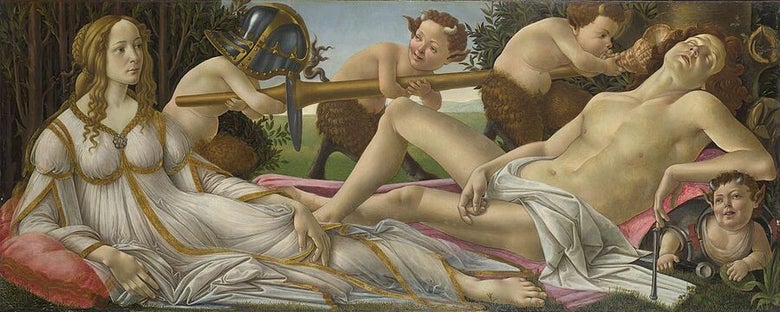
B.M. Scott
3 May 2025
Botticelli’s Venus and Mars: The Authoritarian Observer
In Botticelli’s painting, Venus and Mars, I find myself most aligned with Venus. This is not due to her symbolic role as the divinity of love and beauty within the context of the Roman pantheon, but rather due to the quiet power she holds in a moment where she seems at peace as disorder surrounds her. In this painting, Venus lies awake and alert as Mars sleeps beside her utterly spent – the god of war left defenseless and unguarded. This contrast between the two figures—the awake and composed Venus beside the slumbering Mars—speaks to the power and depth of presence, poise, and control. In this respect, Botticelli instils her with a quiet authority and it’s this aspect of her that most resonates with me. Her eyes are open, and her gaze fixed somewhere in the distance almost as if she is watching over the scene fully aware of her surroundings but at ease with her position. This composure strikes me as a reflection of internal strength - the ability to remain grounded and self-assured, even when everything feels chaotic and all-consuming.
There is a certain element of “placelessness” within the context of Venus as subject. This placelessness gives interesting insight into the role of the observer – or what observation means to Botticelli from the passiveness of youth to authoritarian reflection. Botticelli’s figures result from the tension between the artist’s interest in both linearity and through their unidealized naturalism. Venus’ control in the painting contrasts sharply with Mars’s vulnerability – urging the notion, “is this a reflection of outer expressions and inner realities in conflict?” Mars, as the god of war, is depicted as powerless in this moment - laid bare by exhaustion and love, making him defenseless by the playful satyrs who steal his weapons. I recognize this dynamic from situations where others may seem powerful, only to later see that this external strength can be fleeting or superficial – used in moments of desperation to achieve a specific end. Venus, by contrast, doesn’t need armor or weapons to hold her power. Her presence is her strength. Venus watches over the scene, composed and untouched - while Mars is completely unraveled by the intensity of his own experiences.
The satyrs that surround the two divinities represent a kind of playful anarchy, tugging at Mars’s armor and turning the tools of war into toys or playful items. These mischievous figures suggest the unpredictability of life – unforeseen moments when things spiral out of control or take unexpected turns. Yet again, Venus is untouched by the commotion - her gaze fixed ahead and her calm demeanor unaffected by the discord surrounding her. In life, I’ve encountered similar moments where unexpected disruptions or chaotic circumstances have threatened to pull me off course. In those instances, I’ve had to learn to remain steady – viz., focused on what I can control, and allowing the noise to fall away. It’s not about being detached or uncaring but about knowing where your power lies and refusing to be pulled into unnecessary turmoil.
There is an important balance despite my natural inclinations to resonate with the neutral observer, personally speaking. The goddess of love isn’t passive or brittle, despite her peaceful demeanor. Her power comes from her composure; her ability to stay present and steady while the world around her shifts. Mars, for all his physical prowess, is undone by the very things that make him powerful - his passion, aggression, and need for action. Venus, on the other hand, embodies a different kind of strength - the strength to remain calm, collected, and centered; even when life feels overwhelming. What I find most compelling about Venus in this painting is her ability to hold power in stillness - she simply is, and that is enough. In a world that often feels messy and volatile, I am mesmerized by her quiet resilience - her ability to stay grounded in her own presence, and her power to find peace amidst the unending conflict fueled by humanity’s passion and predation.
Invitation for Reflection
- How does Botticelli’s depiction of Venus invert or complicate traditional notions of power and authority—particularly in contrast to Mars? What does her quiet composure suggest about the nature of inner strength?
- In what ways does the painting’s dynamic between Venus and Mars invite you to reconsider the relationship between outward expression and inner reality? Can power exist independently of action, offense, or defense?
- Reflect on the concept of placelessness as it pertains to Venus. How might her poised observation, situated outside immediate conflict, shed light on the role of the “observer” in moments of upheaval—be it personal, historical, or artistic?
- What do the satyrs’ playful disruption of Mars’s armor signify about the unpredictability of life and the limitations of conventional power? How does Venus’s detachment from this chaos shape your understanding of agency?
- Consider moments in your own experience when composure, rather than force or reaction, served as a source of genuine strength. How did this affect your perception of control?
- How might Venus’s stillness and self-possession serve as a model to engage moments discord and volatility in everyday life? What does this suggest about the potential virtues of grounding oneself in presence, rather than seeking resolution through constant struggle?
Further Reading
Freedman, Luba. “Ovid and the Metamorphoses of Modern Art from Botticelli to Picasso.” Renaissance
Quarterly, vol. 69, no. 1, 2016, pp. 231–245.
Melius, Jeremy Norman. Art History and the Invention of Botticelli. 2010. Berkely Dissertation,
University of California. 2010.
Nelson, Jonathan. “An Unpublished Essay by Mary Berenson: Botticelli and His Critics.” Interdisciplinary Studies
in the Long Nineteenth Century, vol. 2019, pp. 1-16. no. 28, 2019.
Nivre, Elisabeth. Allusions and Reflections: Greek and Roman Mythology in Renaissance Europe.
Cambridge Scholars Publishing, 2015.
Add comment
Comments